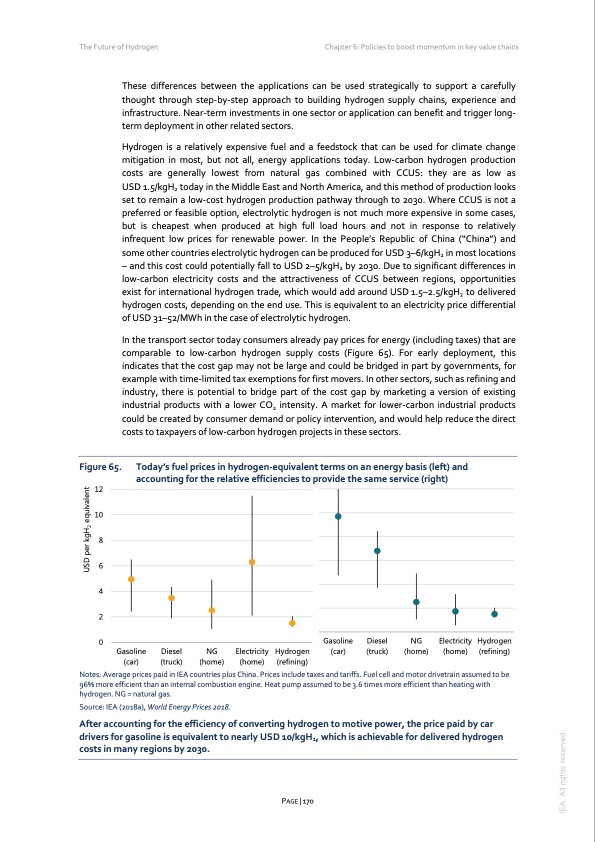
PDF Publication Title:
Text from PDF Page: 170
The Future of Hydrogen Chapter 6: Policies to boost momentum in key value chains 12 10 8 6 4 2 0 Gasoline (car) (truck) NG Electricity (home) (home) Hydrogen (refining) Gasoline Diesel (car) (truck) NG Electricity Hydrogen (home) (home) (refining) These differences between the applications can be used strategically to support a carefully thought through step-by-step approach to building hydrogen supply chains, experience and infrastructure. Near-term investments in one sector or application can benefit and trigger long- term deployment in other related sectors. Hydrogen is a relatively expensive fuel and a feedstock that can be used for climate change mitigation in most, but not all, energy applications today. Low-carbon hydrogen production costs are generally lowest from natural gas combined with CCUS: they are as low as USD 1.5/kgH2 today in the Middle East and North America, and this method of production looks set to remain a low-cost hydrogen production pathway through to 2030. Where CCUS is not a preferred or feasible option, electrolytic hydrogen is not much more expensive in some cases, but is cheapest when produced at high full load hours and not in response to relatively infrequent low prices for renewable power. In the People’s Republic of China (“China”) and some other countries electrolytic hydrogen can be produced for USD 3–6/kgH2 in most locations – and this cost could potentially fall to USD 2–5/kgH2 by 2030. Due to significant differences in low-carbon electricity costs and the attractiveness of CCUS between regions, opportunities exist for international hydrogen trade, which would add around USD 1.5–2.5/kgH2 to delivered hydrogen costs, depending on the end use. This is equivalent to an electricity price differential of USD 31–52/MWh in the case of electrolytic hydrogen. In the transport sector today consumers already pay prices for energy (including taxes) that are comparable to low-carbon hydrogen supply costs (Figure 65). For early deployment, this indicates that the cost gap may not be large and could be bridged in part by governments, for example with time-limited tax exemptions for first movers. In other sectors, such as refining and industry, there is potential to bridge part of the cost gap by marketing a version of existing industrial products with a lower CO2 intensity. A market for lower-carbon industrial products could be created by consumer demand or policy intervention, and would help reduce the direct costs to taxpayers of low-carbon hydrogen projects in these sectors. Figure 65. Today’s fuel prices in hydrogen-equivalent terms on an energy basis (left) and accounting for the relative efficiencies to provide the same service (right) Diesel Notes: Average prices paid in IEA countries plus China. Prices include taxes and tariffs. Fuel cell and motor drivetrain assumed to be 96% more efficient than an internal combustion engine. Heat pump assumed to be 3.6 times more efficient than heating with hydrogen. NG = natural gas. Source: IEA (2018a), World Energy Prices 2018. After accounting for the efficiency of converting hydrogen to motive power, the price paid by car drivers for gasoline is equivalent to nearly USD 10/kgH2, which is achievable for delivered hydrogen costs in many regions by 2030. PAGE | 170 IEA. All rights reserved. USD per kgH2 equivalentPDF Image | The Future of Hydrogen 2019

PDF Search Title:
The Future of Hydrogen 2019Original File Name Searched:
the_future_of_hydrogen.pdfDIY PDF Search: Google It | Yahoo | Bing
NFT (Non Fungible Token): Buy our tech, design, development or system NFT and become part of our tech NFT network... More Info
IT XR Project Redstone NFT Available for Sale: NFT for high tech turbine design with one part 3D printed counter-rotating energy turbine. Be part of the future with this NFT. Can be bought and sold but only one design NFT exists. Royalties go to the developer (Infinity) to keep enhancing design and applications... More Info
Infinity Turbine IT XR Project Redstone Design: NFT for sale... NFT for high tech turbine design with one part 3D printed counter-rotating energy turbine. Includes all rights to this turbine design, including license for Fluid Handling Block I and II for the turbine assembly and housing. The NFT includes the blueprints (cad/cam), revenue streams, and all future development of the IT XR Project Redstone... More Info
Infinity Turbine ROT Radial Outflow Turbine 24 Design and Worldwide Rights: NFT for sale... NFT for the ROT 24 energy turbine. Be part of the future with this NFT. This design can be bought and sold but only one design NFT exists. You may manufacture the unit, or get the revenues from its sale from Infinity Turbine. Royalties go to the developer (Infinity) to keep enhancing design and applications... More Info
Infinity Supercritical CO2 10 Liter Extractor Design and Worldwide Rights: The Infinity Supercritical 10L CO2 extractor is for botanical oil extraction, which is rich in terpenes and can produce shelf ready full spectrum oil. With over 5 years of development, this industry leader mature extractor machine has been sold since 2015 and is part of many profitable businesses. The process can also be used for electrowinning, e-waste recycling, and lithium battery recycling, gold mining electronic wastes, precious metals. CO2 can also be used in a reverse fuel cell with nafion to make a gas-to-liquids fuel, such as methanol, ethanol and butanol or ethylene. Supercritical CO2 has also been used for treating nafion to make it more effective catalyst. This NFT is for the purchase of worldwide rights which includes the design. More Info
NFT (Non Fungible Token): Buy our tech, design, development or system NFT and become part of our tech NFT network... More Info
Infinity Turbine Products: Special for this month, any plans are $10,000 for complete Cad/Cam blueprints. License is for one build. Try before you buy a production license. May pay by Bitcoin or other Crypto. Products Page... More Info
| CONTACT TEL: 608-238-6001 Email: greg@infinityturbine.com | RSS | AMP |